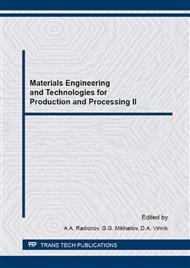[1]
Y.A. Luponosov, Claydite production with the use of oil sludge waste, Synopsis of thesis, Samara, (1998).
Google Scholar
[2]
V.V. Kroz, О.V. Kulikovskaya, N.I. Belomerya, Obtaining heat-insulating materials from technogenic products, Proceeding in Materials of the 5th International Research and Practice Conference and Exhibition, Environmental problems of industrial megalopolises, Donetsk National Technical Universitym, Donetsk. (2008).
Google Scholar
[3]
I. Ya. Guzman, The chemical technology of ceramic: Study guide for higher educational institutions, Building materials, Moscow, (2003).
Google Scholar
[4]
S.P. Onatsky, Claydite production, third ed., updated and revised, Stroyizdat, Moscow, (1987).
Google Scholar
[5]
P.P. Budnikov, D.N. Poluboyarinov, The chemical technology of ceramics and refractory materials, Stroyizd, Moscow, (1972).
Google Scholar
[6]
А.М. Salakhov, R.А. Salakhova, Ceramics: raw material research, structure, properties: Study guide, KSTU, Kazan, (2013).
Google Scholar
[7]
N. Yu. Kiryushina, S.V. Sverguzova, Purification of electroplating industry wastewater from Fe2+, Fe3+, Zn2+ ions with electric-furnace steelmaking slag: Monograph, Belgorod, (2013).
Google Scholar
[8]
HS 2. 1. 5. 689-98, Maximum concentration limits of chemical substances in water bodies for household water use and cultural and general use.
Google Scholar
[9]
N.S. Lupandina, Z.A. Sapronova, S.V. Svergusova, V.S. Lesovik, Copper and Nickel Substances Extraction from Water Mediums by Waste of Disaccharide Production, Journal of Engineering and Applied Scinces 9 (8). (2014) 310-315.
Google Scholar
[10]
L.I. Mirkin, X-ray polycrystal structure analysis: Reference book, Fizmatlit, Moscow, (1961).
Google Scholar
[11]
S.S. Gorelik, Yu.А. Skakov, L.N. Rastorguev, X-ray and electro-optical analysis, MISIS, Moscow, (2000).
Google Scholar
[12]
Yu.М. Butt, V.V. Timashev, Practical course of binding materials chemical technology: Study guide for chemical and engineering specialties in higher educational institutions, Vysshaya shkola, Moscow, (1973).
Google Scholar
[13]
V.S. Gorshkov, V.V. Timashev, V.G. Savelyev, Methods of physical and chemical analysis of binders: Study guide, Vysshaya shkola, Moscow, (1981).
Google Scholar
[14]
А.I. Avgustinnik, Ceramics, Stroyizdat, Leningrad, (1975).
Google Scholar
[15]
А.А. Krupa, V.S. Gorodov, The chemical technology of ceramic materials, V. Sh., Kiev, (1990).
Google Scholar
[16]
GOST 9757-90, Artificial porous gravel, breakstone and sand: Technic specifications.
Google Scholar
[17]
V.K. Kanaev, New technology of building ceramics, Stroyizdat, Moscow, (1990).
Google Scholar
[18]
W. Abdel-Halim, D. Weichgrebe, K. -H. Rosenwinkel, J. Verink, Sustanable sewage treatment and re-use in developing countries 12-th international conference, IWTC 12. (2008) 1397-1409.
Google Scholar
[19]
S.S. Vinogradov, Environmentally friendly electroplating industry, Globus, Moscow, (1998).
Google Scholar
[20]
H. El-Fadaly, Chemical and microbiological Analyses of certain water sources and industrial wastewater samples in Egypt, Pakistan Journal of biological Sciences. 3 (20010) 777-781.
DOI: 10.3923/pjbs.2000.777.781
Google Scholar


